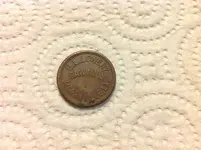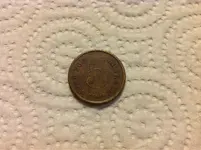You are using an out of date browser. It may not display this or other websites correctly.
You should upgrade or use an alternative browser.
You should upgrade or use an alternative browser.
E.L. Lowery Saw Mill Token
- Thread starter Krusty
- Start date
intimer
Hero Member
your 5¢ is unlisted - only the 10 ¢ is listed in trantow's lumber catalog. it is listed R-10.
there are a few words written about the company in the catalog.
"ernest lowery is listed for: a gen'l store in Merryville and hackberry (20 miles SSW of lake Charles) from 1934-44; a sawmill, selling building materials and hardware in the late 1940's and a sawmill and commissary in the 1950's."
your's in great condition, would be highly sought after by collectors.
mike w.
there are a few words written about the company in the catalog.
"ernest lowery is listed for: a gen'l store in Merryville and hackberry (20 miles SSW of lake Charles) from 1934-44; a sawmill, selling building materials and hardware in the late 1940's and a sawmill and commissary in the 1950's."
your's in great condition, would be highly sought after by collectors.
mike w.
Krusty
Jr. Member
- #4
Thread Owner
your 5¢ is unlisted - only the 10 ¢ is listed in trantow's lumber catalog. it is listed R-10.
there are a few words written about the company in the catalog.
"ernest lowery is listed for: a gen'l store in Merryville and hackberry (20 miles SSW of lake Charles) from 1934-44; a sawmill, selling building materials and hardware in the late 1940's and a sawmill and commissary in the 1950's."
your's in great condition, would be highly sought after by collectors.
mike w.
Would you happen to have a link for that catalog?
intimer
Hero Member
it's a token catalog by terry trantow published and sold by the national scrip collectors association, inc. website natonalscripcollectors.org
Krusty
Jr. Member
- #6
Thread Owner
I did find this catalog on the Internet. I saw it was selling for around 75 dollars. I noticed you said it was rare with an R10 rating. I have been to a few websites and have gotten mixed rating reviews. I read one website said R10 rating was only one in existence. Another one said R10 was mass produced. I am not up too speed with the tokens....lol.
idahotokens
Bronze Member
Krusty--Crawford & Farber's Louisiana Trade Tokens book (available at TAMS Home) pretty much copies what Trantow's Lumber Tokens book says. They do add a "desirability" rating of C on a scale from A to G with A being highest.
There is no standard for token rarity. That is because the hobby and resulting marketplace has not matured like that for coins. It is relatively easy to find the buy and sell prices for a given United States coin. There are books, online lists, dealers in most larger towns, etc. etc. Trade tokens, on the other hand, have only been seriously collected for 50 or so years and new discoveries are popping up daily - thanks in a large part to metal detectorists. There are so many different tokens out there that a collector almost has to specialize (or have deep pockets). Most specialize by state - the first state catalogs were put out in the 1960s and some states have yet to have a catalog written. One of the early catalogs had a 1-7 rarity scale. I've seen several other scales, including the 1-10 scale. But keep in mind that rarity does not equate to value. Supply, desirability and demand are the main factors in determining token values. Some states and types of tokens are way more popular than others.
When someone takes on the task of writing a state token catalog, that person only knows what others are willing to tell him when it comes to rarity. Many people might tell the cataloger that they have a certain token, but might not want it known that they have a dozen others just like it. Letting that info out would kill the value of what they have. Human nature...
If you are interested in collecting trade tokens as a hobby, it would pay to get a copy of the books for the areas of your interest. And then join one of the token groups so you can meet others with similar interests. Tokens are fascinating bits of history and can be studied as deeply as you want.
John in the Great 208
There is no standard for token rarity. That is because the hobby and resulting marketplace has not matured like that for coins. It is relatively easy to find the buy and sell prices for a given United States coin. There are books, online lists, dealers in most larger towns, etc. etc. Trade tokens, on the other hand, have only been seriously collected for 50 or so years and new discoveries are popping up daily - thanks in a large part to metal detectorists. There are so many different tokens out there that a collector almost has to specialize (or have deep pockets). Most specialize by state - the first state catalogs were put out in the 1960s and some states have yet to have a catalog written. One of the early catalogs had a 1-7 rarity scale. I've seen several other scales, including the 1-10 scale. But keep in mind that rarity does not equate to value. Supply, desirability and demand are the main factors in determining token values. Some states and types of tokens are way more popular than others.
When someone takes on the task of writing a state token catalog, that person only knows what others are willing to tell him when it comes to rarity. Many people might tell the cataloger that they have a certain token, but might not want it known that they have a dozen others just like it. Letting that info out would kill the value of what they have. Human nature...
If you are interested in collecting trade tokens as a hobby, it would pay to get a copy of the books for the areas of your interest. And then join one of the token groups so you can meet others with similar interests. Tokens are fascinating bits of history and can be studied as deeply as you want.
John in the Great 208
Last edited:
intimer
Hero Member
I did find this catalog on the Internet. I saw it was selling for around 75 dollars. I noticed you said it was rare with an R10 rating. I have been to a few websites and have gotten mixed rating reviews. I read one website said R10 rating was only one in existence. Another one said R10 was mass produced. I am not up too speed with the tokens....lol.
the first link below is the NSCA token club listing on ebay at $35 + $5 S/H. next is someones same book at $245. crazy---! the NSCA published and has sold the book since it's first edition in 1979. Tokens were wide ranging in use. NSCA's focus is scrip (obsolete private monies of many industries). some scrip tokens were ordered in qtys of hundreds.... not hundreds of thousands like coins. some companies order thousands but others only hundreds. some more than one order and some only one order. many tokens were turned in during the war years for metal, some were dumped in rivers, mine shafts, melted in furnaces, given to kids to play with...etc. but on the other hand large & small qtys are still being uncovered. the point is scrip tokens are obsolete in their usage by the government in the early 1950's. the mintages were very low compared to other exomnia.
visit the NSCA Inc website at nationalscripcollectors.org
mike w.
Trantow Catalogue of Lumber Co Store Tokens Coal Scrip Second Edition | eBay
Catalogue of Lumber Company Store Tokens Trantow 1998 | eBay
As an eBay Associate we earn from qualifying purchases.
intimer
Hero Member
NSCA also sells 2 differnet volumes of coal scrip.
currently the tird edition is for sale at $20 + $5 S/H
Vol 1 is all states coal scrip (exclusive of WV)
Vol 2 is WV only. (yes the books are similar is size...!)
the 4th edition is currently being edited and will each have over a thousand new listings. bringing the appx total listings to 10,000 each volume. it should be available very late this year. it will sell appx. in the under $50 range.
scrip was very low mintages because it was private company money. larger, longer operating mines likely ordered more and multiple orders. but how the scrip was disposed of after it's use makes it difficult to tell which is rarer than others. the books were first printed in 1977. it is amazing of the effort it must have took without computers. the listings are line by line front and back.
mike w.
currently the tird edition is for sale at $20 + $5 S/H
Vol 1 is all states coal scrip (exclusive of WV)
Vol 2 is WV only. (yes the books are similar is size...!)
the 4th edition is currently being edited and will each have over a thousand new listings. bringing the appx total listings to 10,000 each volume. it should be available very late this year. it will sell appx. in the under $50 range.
scrip was very low mintages because it was private company money. larger, longer operating mines likely ordered more and multiple orders. but how the scrip was disposed of after it's use makes it difficult to tell which is rarer than others. the books were first printed in 1977. it is amazing of the effort it must have took without computers. the listings are line by line front and back.
mike w.
Krusty
Jr. Member
- #10
Thread Owner
Thanks for all the help guys! All of your comments have helped me understand the token business a lot. The more I have researched it the more I have learned they are nothing like coins. They take a lot of research. Finding somebody who is interested in them is also hard to find. I am just happy to know I have these items which are rare finds.
Similar threads
- Replies
- 16
- Views
- 699
Users who are viewing this thread
Total: 1 (members: 0, guests: 1)





